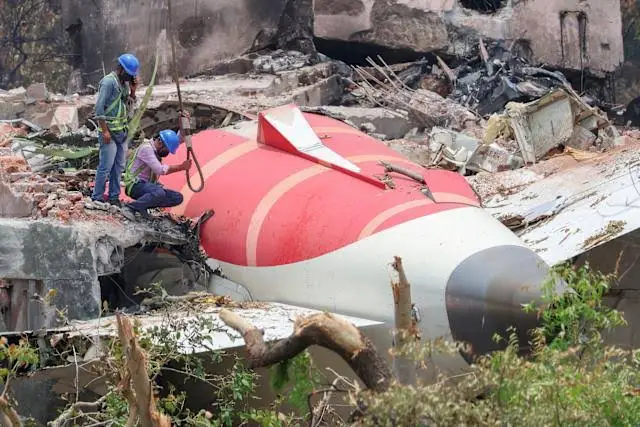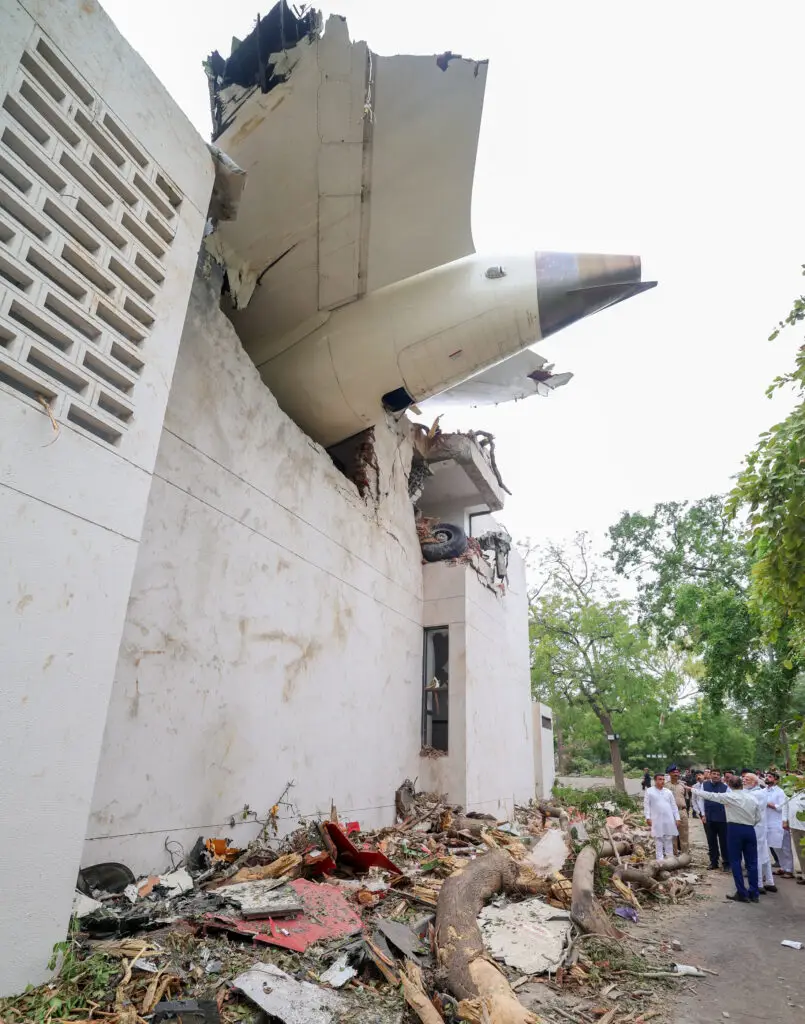AI171 Plane Crash 2025: Aviation & Environmental Safety Crisis
That is black day for the India…AI171 Plane Crash 2025
Date: 12th June 2025
Time: 1:38 PM
Flight: Air India AI171
Location: Meghani Nagar, Ahmedabad, Gujarat
Brief what is happened on that day..
Air India Flight AI171 departed Ahmedabad’s Sardar Vallabhbhai Patel International Airport en route to London Gatwick. Within minutes, eyewitnesses reported strange engine noises and a sudden loss of altitude. Just 7 minutes after take-off, the AI171 Plane crash into the near hostel block of BJ Medical College, causing a massive explosion and a fast-spreading fire that engulfed nearby structures.
Rescue efforts began immediately but were hindered by debris, smoke, and dangerous heat levels.
Impact of Environment by the AI171 Plane Crash 2025
The Ahmedabad AI171 plane crash of June 12, 2025, wasn’t only an aviation failure—it triggered a chain reaction of ecological harm and public health emergencies. The environmental consequences extended far beyond the wreckage, affecting air, soil, water, and urban livability.
Toxic Emissions and Fire Fallout
The AI171 Plane Crash 2025 ignited approximately 1,25,000 liters of jet fuel, producing an enormous fireball and a plume of black, acrid smoke visible for kilometres. The fire released dangerous gases—carbon monoxide (CO), carbon dioxide (CO₂), nitrogen oxides (NOₓ)—and microscopic particulate matter (PM2.5 and PM10).
These pollutants severely compromised air quality:
- AQI readings in central Ahmedabad spiked to over 450, falling into the “Severe” and “Hazardous” categories.
- Nearby hospitals reported a surge in respiratory distress cases, particularly among children, elderly citizens, and first responders.
- Residents were urged to remain indoors with windows shut, as local air became virtually unbreathable for more than 36 hours.
Soil and Water Contamination
After the AI171 Plane Crash 2025, the crash site and nearby areas were soaked with jet fuel, burned materials, and chemicals used to fight the fire. These harmful substances started leaking into the soil and nearby drainage systems, causing serious environmental concerns:
- Experts warned that PFAS—dangerous “forever chemicals” found in firefighting foam—might be getting into the groundwater, which can affect drinking water supplies.
- Environmental teams found signs of toxic chemicals running off into storm drains and borewells near the crash site.
- Farming areas within 2 kilometers of the crash have been marked for soil testing and possible quarantine to stop contaminated soil from harming crops and people.
The AI171 Plane Crash 2025 has caused pollution that needs careful clean up to protect the environment and the health of local residents.
Ecological Disruption and Wildlife Threats
The AI171 Plane Crash 2025 also highlighted serious risks to local wildlife and the environment. Ahmedabad is close to the Thol Bird Sanctuary, and the presence of open garbage dumps nearby attracts large flocks of birds—especially kites and crows—into the airspace used by planes.
- These birds, drawn by food waste, increase the chances of bird strikes, which can be dangerous for aircraft.
- While the exact cause of the crash is still being investigated, experts believe bird activity may have played a role.
- The crash and resulting fire have damaged the local environment—trees were burned, smoke polluted the air, and chemicals may have entered the soil and water, affecting animals and plants in the area.
The AI171 crash is a reminder that managing wildlife and keeping areas around airports clean is critical for both flight safety and environmental protection.
Long-Term Urban Environmental Fallout
The AI171 Plane Crash 2025 may cause lasting damage to the environment and public health in Ahmedabad. The mix of heavy air pollution, toxic chemical exposure, and destroyed infrastructure could have serious long-term effects:
- People living near the crash site may face a rise in health problems like asthma, bronchitis, and heart disease.
- To reduce future risks, the clean-up process must include proper disposal of hazardous waste, cleaning and restoring the soil, and planting more trees to help bring life and safety back to the area.
The AI171 crash is not just a one-time disaster—it could affect the health and safety of the city for years unless action is taken now.
Aviation and Urban Safety Failures
The AI171 Plane Crash 2025 revealed serious safety problems in both aviation planning and city infrastructure.
Flight Path Risk
- The plane’s flight path went over crowded residential areas with no protected no-fly zones.
- Rapid urban growth and tall buildings near the airport broke older aviation safety rules, making crashes more likely.
Poor Wildlife Control
- Garbage dumps just 5–8 km from the airport attracted many birds like kites, crows, and pigeons.
- Even though experts had raised concerns earlier, there were no working bird detection systems or bird control measures in place.
Weak Emergency Response
- Fire trucks and rescue teams were delayed because of blocked roads and damaged buildings.
- Even though hospitals were nearby, power cuts and structural damage made emergency care slow and difficult.
The AI171 crash shows how weak planning and poor coordination between city systems and aviation safety can lead to disaster. These failures must be fixed to prevent future tragedies.
Damage and Loss Assessment
| Category | Estimated Impact |
| Human Lives Lost | 270+ |
| Air Quality Impact | AQI reached 450–500+ (“Hazardous”) |
| Soil/Water Testing Zones | 14 contaminated zones identified |
| Buildings Destroyed | 6+ including hostel wings and labs |
Mitigation and Response: What’s Being Done?
After the AI171 Plane Crash 2025, several emergency and long-term actions have been taken to manage the crisis and prevent future disasters.
Short-Term Actions
- The DGCA (India’s aviation regulator) has ordered urgent checks on all Dreamliner aircraft engines and systems.
- Air quality alerts were sent across Ahmedabad; schools and clinics in affected areas were temporarily closed.
- The Ahmedabad Municipal Corporation (AMC) sent water tankers and air purifiers to Meghani Nagar to support local residents.
Medium-Term Efforts
- The Gujarat Pollution Control Board began a fast-tracked environmental damage assessment.
- The National Disaster Response Force (NDRF) is removing harmful foam residues and cleaning up contaminated soil at the crash site.
http://ndrf.gov.in
https://gpcb.gujarat.gov.in/Index
Long-Term Recommendations
- Create aviation safety buffer zones around all major Indian airports to reduce crash risk over crowded areas.
- Move all open garbage dumps at least 10 km away from airport runways to reduce bird activity.
- Set up AI-powered bird detection radars and link flight operations to real-time air quality data.
- Enforce building safety laws in areas under airport flight paths to prevent urban hazards.
Lessons Learned: Everything is connected
The AI171 Plane Crash 2025 was not just a tragic accident—it exposed years of problems that had been ignored. Crowded skies, too many birds near runways, garbage dumps close to airports, and fast-growing cities without proper planning all played a part.
This disaster shows that protecting the environment is part of flight safety. Airports can’t operate safely if the space around them is poorly managed.
Final Thoughts: After the Smoke Clears
The Ahmedabad AI171 crash is a turning point. It should not be remembered as just another tragedy. It must be a wake-up call.
This wasn’t just about engine failure—it was about years of ignoring warnings, poor planning, and a lack of environmental care.
Planes don’t just fly through the sky—they fly through air shaped by the way we manage our cities, our waste, and our safety systems.
We owe more than just words to the 270 lives lost.
We owe them real change: safer skies, cleaner cities, and better systems that learn from failure.
The fire may be out. The smoke may be gone.
But what we do next will decide whether this was the end—or a new beginning for responsible aviation.
https://environmentnotifications.in


